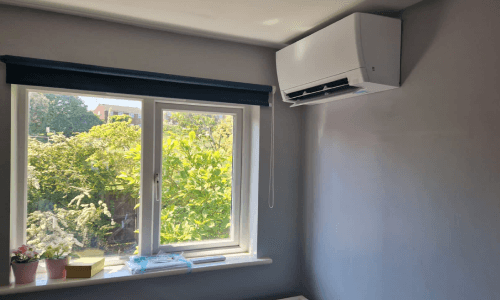Air Conditioning In Hallways: Why it may not be ideal for your home
Table of Contents

Air Conditioning In Hallways: Why it may not be ideal for you
Whilst it provides cost effective heating and cooling, having an air conditioner in every room may seem a little excessive, especially with a hallway connecting each room. This can make you wonder whether just one air conditioner in your hallway or landing may be enough to heat/cool the rooms instead. Although this can often lead to a very hot/cold hallway and an overworked air conditioning system, so it may not end up being as money saving as you’d think.
How to decide where to install your AC units
If you’re considering an air conditioning installation at your home, the very first step before you choose what type of air conditioning you want would be to decide where you’d like to install it. Depending on the room you choose, the size and power of the air conditioner can vary significantly and that can have a substantial impact on performance too.
There are four main factors to bear in mind when it comes to selecting which rooms are best to air condition in your property and these include;
Which rooms do you use the most?
Should you work from home, your workspace may seem like an obvious choice, although if that isn’t the case you may consider where you sleep of greater importance. Seeing as we sleep at our best at 18°C, ensuring that temperature is maintained will help you get a good nights rest. Similarly, around 20°C is optimal for your best efficiency whilst working, whether at home or at a workplace. You should also take into consideration how many people may occupy these rooms too. For example, a living room usually inhabited by multiple people will very likely need a lot more power than a singular bedroom occupied by one person.
Do any rooms tend to be especially hot/cold?
If air conditioning is on your mind, it may be because one or more rooms in your home can become especially hot or cold, depending on the time of year. That room could be a conservatory, loft room, kitchen or even an open plan space with large windows. Significant exposure to direct sunlight for most of the day will certainly make a room much warmer, especially in loft spaces because hot air rises from the rooms below. Generally this exposure can be linked to whether the rooms are south-facing as they will receive direct sunlight for the majority of the day, especially in summer. Equally in winter, you will find the same large windows that bring in extra warmth in summer will make it easier for heat to escape in winter. This can be especially prevalent in conservatories and loft rooms as they often lack the same amount of insulation you would expect in other rooms within your home.

How large is the room you’d like to air condition?
One of the most important aspects to consider when selecting the best place suitable for an air conditioning installation is the size of the room or area you want to cool/heat. Larger rooms will always require more powerful AC units, especially if the room contains heat sources such as ovens, significant amounts of electrical equipment or even large windows. As a general rule you can expect a room of around 22 square meters to most likely need a smaller 2.5kw AC system, whereas a room closer to 45 square meters would be best suited to a system around 5kw. Having an idea of your room size will not only help you to get an idea of what size system you will likely need, it will also make it much easier to gauge what sort of installation price you can expect too.
Have you considered the room layout?
Should you have more than one room that is likely going to need air conditioning, if they are connected with a hallway or corridor it may be possible to cool them both with a single air conditioning unit. However, the effectiveness of installing your air conditioner in this way can vary a great deal depending on the actual layout of the hallway and where the adjoining rooms are located as well. For example, if the rooms you’d like to air condition are at opposite ends of the hallway, it will be difficult for a single air conditioner to reach them both. If the hallway is especially long, with a high ceiling if it contains a bend, that can also present an airflow issue which will reduce the effectiveness of the AC unit.
Why Placing Air Conditioners in a Hallway or Landing May Not Be Ideal

With an idea of which rooms in your home you’d like to air condition, the cost of installing an air conditioning unit in each room may look quite daunting, so any saving you can make is certainly welcome. If all the rooms you’d like to air condition are connected by a hallway or landing, it’s a logical assumption that having an air conditioner in that shared space will be able to cool all the connected rooms, provided it is powerful enough. Whilst this may be true in theory, this may not work quite as well in practice because;
Your air conditioning will only sense the temperature in the hallway
Air conditioners have a built-in thermostat sensor so they can detect room temperature, this is why they switch into standby to efficiently save energy when the room has reached the desired temperature. Although this can be problematic when your air conditioner is only detecting the temperature in the hallway as it will primarily regulate the temperature within the room where it is located. For example, if you intend to use a single AC unit to cool all the bedrooms on the upper floor of your home, this means that your air conditioner will first have to cool the hallway before extending to the connecting rooms. This is when the thermostat can present an issue as the air conditioner is actively working to cool/heat the hallway, it will not be able to sense the temperature in the connected rooms. As a result, when the hallway reaches the desired temperature, the air conditioning unit will often switch into standby before the conditioned air can even reach the connected rooms.
Uneven airflow results in uneven heating/cooling in hallways
Even if you opt for a more powerful air conditioning system so it can reach the rooms adjoined to your hallway, this still doesn’t mean you will have sufficient air flow for it to heat/cool them effectively. With the connecting rooms all having different temperatures and potentially being of different sizes, the conditioned air from the hallway will still result in varying temperatures between each room. When this happens you may be tempted to increase the fan speed of the air conditioning system to help boost airflow, although this can make the situation worse as the air will circulate around the hallway and back to the air conditioner before it can reach the other rooms. With the air conditioner thermostat indicating the room has reached the required temperature, it will switch back into standby mode once again. It is also worth bearing in mind that if you have the air conditioner installed on a landing in particular, a considerable amount of the airflow will spill down the staircase too, reducing any heating/cooling effects to the adjoining rooms even further.

An oversized air conditioner will cost more to run
If you install an AC unit in your hallway with a view for it to cool multiple connected rooms, you can expect it will need extra power in order to do so, although this in itself can present an issue. Just like any room with an air conditioner that is more powerful than it needs to be, an overpowered air conditioner operating in a hallway often results in higher running costs and worse still, a decrease in its lifespan too. This may seem odd as it is easy to assume an air conditioning system with more power should just be able to heat/cool faster and cost less with a reduced run time.
In reality, this usually just creates an issue called short cycling. This is when an air conditioning system does not complete its heating/cooling cycle in full as it will switch into standby prematurely before shortly starting up again to repeat the process. This not only results in significant wear and tear for your air conditioning system, it will also use more energy as it powers on and off in an attempt to complete a full cycle. In the case of an oversized air conditioning system in a hallway, this will be triggered by rapid heating/cooling and the AC thermostat indicating the hallway has already reached the correct temperature. The air conditioner will then attempt to go into standby before the conditioned air can reach any of the connected rooms. As the air conditioner continues to attempt a full heating/cooling cycle, it will waste energy powering on and off as it will detect the hallway is still at the correct temperature, providing little heating/cooling to the connected rooms.
Find out more about air conditioning installation costs with expert tips, advice and more by contacting MAC today!
Whether you are looking to install air conditioning at your home or business, MAC have years of experience installing and maintaining a variety of different air conditioning systems throughout the Midlands. With an inhouse team of engineers and experts, MAC can provide you with suggestions and help you find the best air conditioning solution ideal for your specific needs. Call 0121 730 4800 to speak the team today or get your free instant quote online using MAC’s domestic and commercial pricing calculators. Any queries can also be sent to the team via email at sales@midlandaircon.co.uk or even Whatsapp on 07561570029.
Share:
More Posts








